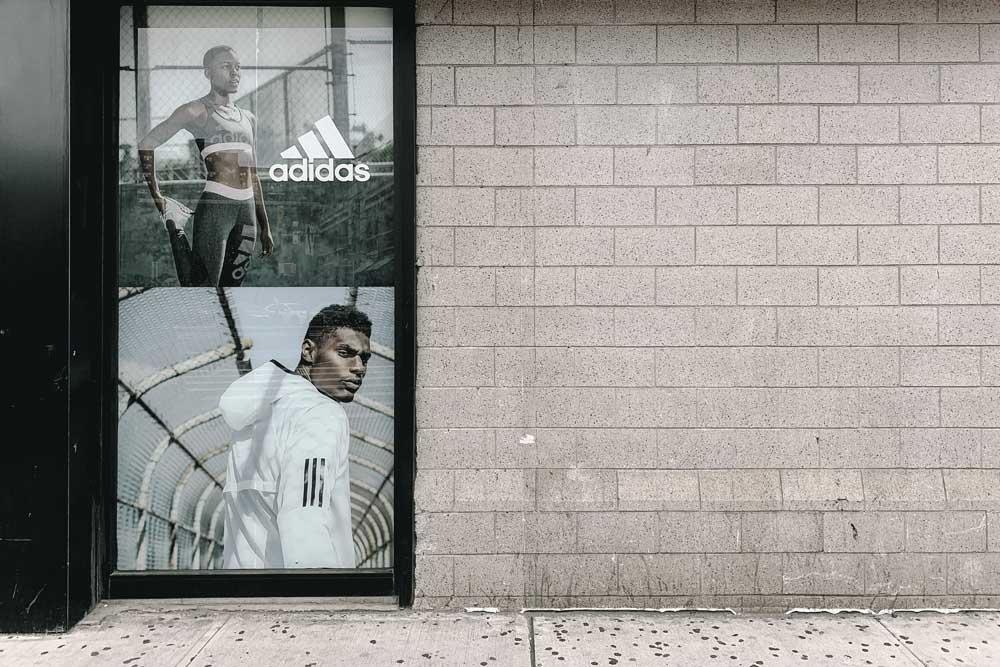Adidas sells diversity — black employees at the Portland campus say it doesn’t practice that
Published 12:00 am Thursday, June 20, 2019

- Marketing materials for Adidas are posted outside a sporting goods store in New York. The few black employees at the North American headquarters of Adidas describe a workplace culture that contradicts the brand’s image as a beacon of diversity.(Haruka Sakaguchi/The New York Times)
In the United States, Adidas has built much of its name — and sales — through its association with black superstars. In the 1980s, the seminal hip-hop group Run-DMC gave the company’s sneakers and apparel cultural cachet through its song “My Adidas.” Popular black athletes and entertainers like James Harden, Candace Parker and Kanye West endorse its products.
In April, Adidas announced a new partnership with Beyoncé Knowles. Knowles posted a photo on Instagram that showed her reclining on a pile of Adidas sneakers and wearing a red Adidas bodysuit. The image was liked more than 7 million times.
Trending
Black employees at the company’s North American headquarters in Portland, however, describe a workplace culture that contradicts the brand’s image. Interviews with more than 20 current or former Adidas employees show the company’s predominantly white leadership struggling with issues of race and discrimination. On the campus, known as Adidas Village, the employees say, race is a constant issue, leaving the relatively few black employees often feeling marginalized and sometimes discriminated against.
Of the nearly 1,700 Adidas employees at the Portland campus, fewer than 4.5% identify as black, according to internal employment figures from last summer that were shared with The New York Times.
Adidas employees who spoke to The Times said that in the company cafeteria, black employees often sit together. Some said they had been told that this made some of their white colleagues nervous and could hurt their chances of getting promotions or being put on important marketing campaigns if it appeared that they were not trying to fit the Adidas mold.
Several current and former Adidas employees said they were frequently the only black person in meetings and often felt their input was not valued when decisions were being made. And an overall lack of racial diversity, they said, meant it was not uncommon for negative stereotypes to creep into work discussions or marketing pitches involving black athletes, sometimes creating backlash outside the company. Even when such ideas were scuttled before becoming part of official advertising campaigns, black employees said, the conversations left them feeling uncomfortable.
For many, the internal tensions at Adidas reflect a larger issue facing the American sports apparel industry, which has a combined annual revenue of more than $20 billion on shoe sales alone. Companies like Adidas, Nike and Under Armour have workforces that are primarily white, but their most influential customers — those who make their products desirable to others — often are not.
In the case of West, Adidas positioned his Yeezy brand as its own category inside the company. Yeezy sales are expected to top $1.3 billion this year. A spokeswoman for West declined to comment.
Trending
The benefits from the collaboration extend beyond selling $350 high-top shoes and high-end designer apparel. Almost overnight, West helped to make Adidas cool again.
After West made his Adidas deal, other hip-hop stars like Pusha T established relationships with the company. Pharrell Williams, who was already working with Adidas, signed a new deal.
“I think Adidas is trying to align itself with the fans of those artists,” said Matt Powell, an analyst with NPD Group. “These artists have tremendous followings and fans. Those fans want to dress like their idols.”
It is much different inside the company. Fewer than 75 of the nearly 1,700 Adidas employees in Portland identify as black, according to the internal employment figures from last summer. Nearly 78% of the employees are white.
An Adidas spokeswoman, Stacey Marsh, did not dispute the figures obtained by The Times, and declined to comment on the composition of the staff at the company’s Portland headquarters. She said that 55% of the company’s total employee base in the United States, which includes employees paid hourly wages in its retail stores, were people of color.
Only three people of Adidas’s roughly 340 worldwide vice presidents last year were black, according to two people with knowledge of the figures. One of the black executives has since departed.
Marsh said that Adidas could not provide information on the race or ethnicity of its employees at a global level because of country-specific laws.
The employee figures for other sports apparel giants are similarly stark. Last year, when Footwear News highlighted the top 40 people under 40 who it said were revolutionizing the shoe industry, the list did not include a single black person.
Nike says that at the end of 2017, about 23% of its American employees, including those working at its retail stores, were black. Of the company’s 353 vice presidents, 29, or 8%, were black.
Under Armour’s website lists its goals related to diversity and inclusion, but the company declined to provide data on the makeup of its workforce for this article.
“Companies spend billions of dollars on marketing and advertising to attract African American kids to their products, but they don’t do much to support the African Americans on the inside,” said D’Wayne Edwards, who started designing shoes in 1989 and worked at Nike, where he designed Air Jordan shoes. He now runs Pensole Footwear Design Academy in Portland.
“What is frustrating is that none of us are empowered to change it,” he added. “Some companies have said for years that they want to create a diverse workplace, but if anything, the numbers are getting worse. And they don’t care. It’s a lot of lip service.”








